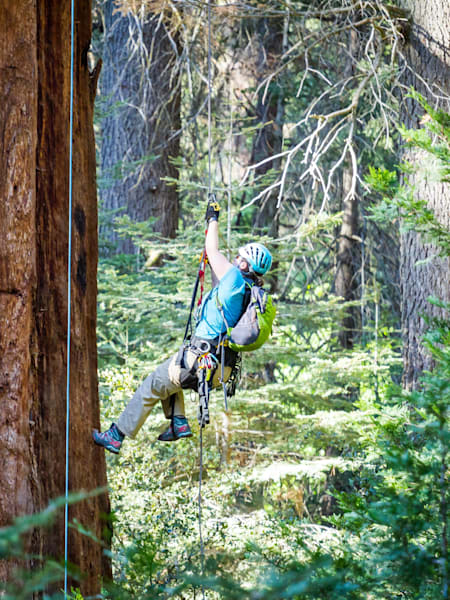Tree climbing is a thing. And Dave Katz is one of the world’s best at it. A founding member of the Cornell Tree Climbing Institute, he's climbed trees across the world and taught the technical skills needed to climb trees to plenty. We speak to him about how to get into tree climbing and what the biggest dangers are when taking on these giants.
How did you get into tree climbing?
I started when I was a kid, climbing trees in my backyard, and as I learned to rock and ice climb I thought ‘hey, I can apply some of these techniques to climbing bigger trees’. So I started in the forests near my home of New York then set my sights on bigger, more challenging trees.
So, how do you go about starting to climb a massive tree?
You use a crossbow and fishing reel! You shoot it up into the tree and once it comes back down you pull up a climbing rope and tie it off then climb up the rope step by step.
What are the main technical crossovers from traditional climbing?
The ascenders and rope techniques we use are similar to those you’d use to climb a big wall or an ice field. You attach two ascenders to the rope, one attached to your harness and the other to your feet, and you do the ‘Texas Kick’ to climb the rope. There isn’t any other way to climb these giant trees because they’re so big around.
And what are the differences to traditional climbing?
With rock climbing there’s, like, 50 different types of snow, 40 types of ice, 50 types of rock. In tree climbing, there are so many different types of tree and every tree is different because it has different architecture. That’s what makes it so fascinating and challenging.
What's the hardest thing about climbing a tree?
What controls the difficulty is not so much climbing ability, but the ability to understand the tree you're climbing. There are a lot of different controls you need to know – like the height, age, architecture of branches, what’s in the way – before you can take it on.
And what are the biggest dangers?
We’re usually only tied off to one piece of the tree, so if anything goes wrong you’d just fall off and die. We have to be really, really careful and it’s more about prevention than reaction. The unpredictable dangers come when things fall or when conditions change rapidly and you have to make a quick descent. But most of the time you can just get to the ground – it’s not like being days up on a wall and it’s hard to get back.
What are the worst things that have happened to you?
I’ve been stung by huge swarms of wasps, branches have fallen down and hit me and once I accidentally untied myself from the rope! That was on a Sequoia after working for 15 hours – I just unclipped something and was, like, ‘Uh, OK, so now I’m not attached to anything, that’s not good…’
Where are the most challenging trees?
The tropics, because the trees are big, you can’t often see the branches and there are lots of things in the way – like flying snakes, weird ants, bees, wasps and pit vipers!
How does it feel to get to the top?
There’s definitely a feeling of respect when you get up a tree, but generally we don’t see it as conquering it. It’s more checking it out and exploring it. Sometimes reaching the top is not even possible, it depends where you’re climbing. But it’s a nice bonus being able to look out over a sea of other trees like being on top of a summit and overlooking the mountains below.
What do you do when you're exploring the tree?
Sometimes we’ll spend days up there, photographing, researching and moving around it. Often it’s easier to stay up there than come back down because we’re 100m up and we’ve got all this equipment, so we just take hammocks and food and stay up there.
How can people get into tree climbing?
There are quite a few programmes that teach techniques like we do at the Cornell Tree Climbing Institute. We offer classes for researchers and educators, programmes for youth groups and even do birthday parties! Anyone who wants to climb a tree, we can help you out!
And what about going far afield?
You can’t just go climb a tree anywhere, you need to prepare and you often need permission to climb, but we can usually figure that out. We do a course every year in Costa Rica, which is more like an organised holiday, and a couple of times a year I co-ordinate expeditions that go to far-flung places to climb trees.
So what would be the dream trip?
You could have a great expedition in Madagascar, Borneo or India. They have champion trees. In fact, doing all three together would make an awesome trip...!









